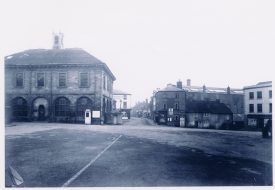The early museum
A museum has existed at Market Hall since 1836, when the Warwickshire Natural History and Archaeological Society hired some rooms in the centre of Warwick. Expanding rapidly, by 1840 the whole of the top part of the Market Hall was in use. As members dwindled and the society struggled for money, in 1932 the Society offered the collections to the council. Plans were put in place to restore and renovate the museum, but the Second World War put a stop to proceedings. The military took over the Market Hall building, and the collections were moved to temporary housing at the Abbotsford.
In a sorry state
This state of affairs was not good for the collections! By the end of the war, the Abbotsford was in a sorry state. A report in the Warwick Advertiser of 7th February 1947 was particularly damning. They reported how they expected the door to fall to the ground on its opening, so rusty were the hinges, whilst inside the reporter was “confronted with an odour of dampness and dry rot, while draughts blew through a shattered window in the wall.” These walls, meanwhile, were reported to be “in an advanced state of decomposition.”
The collections may have been suffering in these conditions, but it wasn’t as though anybody was able to see them easily. School parties were unable to visit the museum, as the floors were deemed unsafe.
Hopes for a return to the Market Hall hung in the balance also. The Advertiser of 11th May 1951 reported how public appetite for the Market Hall’s delayed renovation had not been overwhelming. There were suggestions that the building might be better used as a youth centre, or even demolished altogether!
A remarkable transformation
Despite these reservations, the plans to renovate the Market Hall were revived. By the time of the 1951 re-opening, any doubts about the project had been dispelled. The Advertiser gushed how “a remarkable transformation has been effected.” Meanwhile, the council chairman, Ald. G.H. Bryant, asserted the museum’s appeal not just as an educational asset, but as a tourist attraction that overseas visitors would come to. The museum, in fact, was seen as a contribution by the council to the Festival of Britain.
The collections, then, were returned to their traditional home and the Market Hall building had been saved. Renewed and refreshed, a new chapter in the history of the Market Hall building and its collections had begun.










Comments
The Museum was run by the wonderful Jocelyn Morris, who achieved so much in some 30 years in Warwick. She died last year in her late 90s, an inspiration to the many of us who knew her.
Can I just make out the fountain that once stood in the market place?
Add a comment about this page